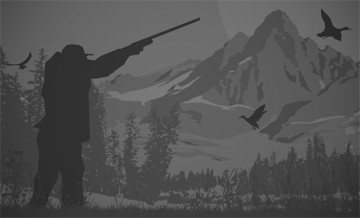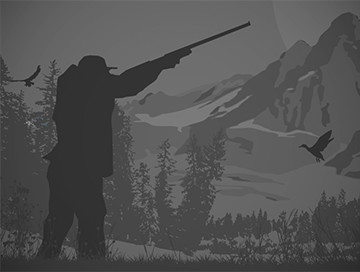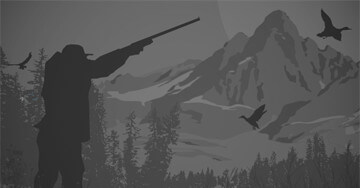High Seat on map
About High Seat
Humans have been trying to get at their quarry from above ever since they learned to hunt. Over time, the high seat evolved from a few sticks across two horizontal branches to high-tech American tree stands or permanent blinds the size and comfort of a third-world house, but whatever the shape, it is an inalienable part of most known hunting traditions. An elevated position gives you a commanding view and carries your smell over the animals' nostrils, which is especially useful in places where the birds and beasts are most wary. Some hunters despise hunting from a stand, thinking it is too easy. In reality, it's harder than it seems, and has its share of complications, challenges and even risks. Read more...
Most big-game animals rely on their sense of smell to avoid predators, especially in areas that they can't avoid, and where they know the level of danger is greatest, such as waterholes and concentrations of good food. But if you can get about three meters (approximately 10 Feet) or higher above the ground the winds carry the hunter's smell over the quarry's noses, and the chances the animal will smell you decrease dramatically or at least fools them into thinking you are further away and less of a threat. This is especially valuable for hunting with a bow, or areas where only short-range weapons are allowed. The most common type of a high seat is a tree stand, either a production model, or an improvised construction built on the spot out of logs and sticks. Such stands can be put up or moved at short notice depending on animal movements, where the bait was laid, travel routes or where the animals are visiting the food sources. Where there are no trees available, some outfitters place their hunters above ground on tripods, tepee-like constructions of long poles with a seat on top, or similar designs that look like oversized folding chairs. Permanent high seats are erected in places where you can hope to see game year after year, like a waterhole, a food plot, or even an artificial feeder. Hunting from a permanent high seat is an ancient tradition in many European countries. You can't drive through the German countryside, for example, without seeing a few of them on the edges of fields and forests. One of the main reasons for their abundance is the interests of public safety. A permanent stand acts as a warning sign, telling the general public where a hunter may be, and the windows for shooting are positioned so that no houses, roads, etc. are in the firing line. In addition, the bullet that is fired from an elevation downwards will soon strike the ground rather than travel well over the horizon and hit an unseen an unintended target. The biggest challenge of hunting from a stand is that they’re usually positioned in localities where animals expect danger and are most wary. Even in predator-free Western Europe the roe and boar have seen danger come from high seats for centuries, and learned to adapt. The animals have a problem smelling you when you're above the ground, but they still can, and any noise you make is carried even farther. You must act as if you’re not there at all - no smell, no movement, and above all no sound. The hardest thing in it, for novices at least, is that you must exercise equal caution when the quarry is near, and when it looks and feels that there isn’t a single living thing in the ten-mile radius. That may be exactly when the object of the chase is making up its mind whether to come into the open or steal away. Keeping still and silent may be the biggest challenge of your life - like, when waiting for a bear over a Russian oat field, perched on a typical improvised stand made of planks nailed to a tree and surrounded by a cloud of mosquitoes. But even in a comfortable permanent stand any careless move will cost you your chance. Shooting from a high stand has its complications too. It's said that a miss is in your head, and at no time is a hunter is so likely to miss as when they are overconfident and feel their quarry is as good as in the freezer. This is precisely the illusion that many outfitted high seat hunts will give you - but your trophy will remain illusory unless you do your job. And don't forget that a miss from a stand usually means the hunting is over - few animals will approach the spot after this obvious warning of danger. Last but not the least, surprisingly many hunters forget to allow for elevation when taking aim, and hold for the same spot as if they were on the same plane with the animal. This may cause the bullet or arrow to pass below the vitals and only wound the animal. You must imagine the path where you want the bullet to travel then exit and compensate your aiming point accordingly. Caution is needed when you get up the stand, and especially as you get down. And especially if you've hit, or worse, wounded a head of game. It's all too easy to forget yourself and rush down with a loaded weapon at the ready - and pay with a bad fall, broken bones, or worse. When you ascend to or descend from the high stand your weapon must be unloaded, and better yet cased. And if you hunt from a tree stand that you have to climb, the adamant rule is to use a string and pull your unloaded weapon up and down with its help. On an outfitted hunt you are usually relieved of the most difficult part of the job: finding the right spot to position your high seat. Your guide knows his area, the bedding and feeding areas and thus the best placement of the stands; following their instructions is normally the surest ticket to success. However, as you gain experience, you will more and more often find yourself in a situation where the placement just doesn't seem right and you may want to discuss moving your stand with your guide. Whether to rely on the guide's experience and knowledge of terrain, or request they move you to another place, may prove a very difficult dilemma. The correct solution will depend on many factors, but the rule of thumb is: when in doubt, trust the guide. The best thing about hunting from a high seat is the opportunity that it allows you to blend in with the environment. Sit still for fifteen minutes, and chances are you won't want to move. You will experience nature in its purest form. See a songbird bravely chase a raven from its nesting area, chuckle at two hares boxing for a female during one of their many ruts a year, feel shiver down your spine as wolves howl in the distance - only location and season are the limit to the intimate scenes from the life of nature that you may witness, until that hot wave of adrenaline rushes through you as you hear a rustle of leaves or a twig snap from a step of your quarry... Discover your opportunities for hunting from a high stand with BookYourHunt. Hide details
Interested in High Seat trips? Create a subscription to get offers right to your inbox




